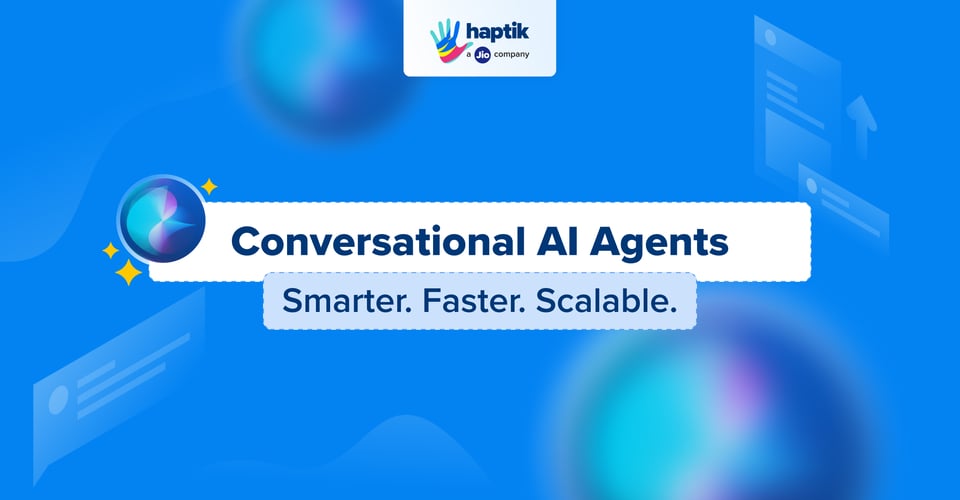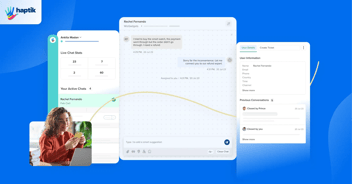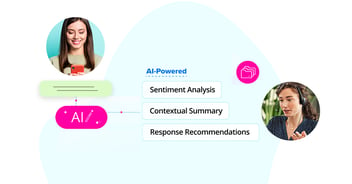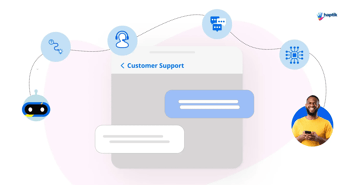Are Conversational AI Agents Just Fancy Chatbots?

Lately, you’ve probably seen the term Conversational AI Agent popping up everywhere - in product announcements, sales pitches, webinars, and LinkedIn posts. It’s being positioned as the next big thing in customer experience. But somewhere in the back of your mind, you’re probably thinking: “Wait a second... isn’t this just a chatbot with a fresh coat of paint?” The short answer? Yes. But also, not really. Let’s unpack that.
Meet Haptik’s AI Agents: The Powerhouse of Human-Like Customer Experiences
Let’s Be Honest - We All Know What A Chatbot Is
They are software that allows humans to interact with machines using natural language, whether typed or spoken. We know chatbots live inside messaging apps, websites, or voice interfaces, built to answer queries, assist with tasks, or just hold a conversation.
So far, nothing new.
So Then… What Is a Conversational AI Agent?
At first glance, AI Agents seem to do the same thing. They also let users chat with a machine and get things done.
So yes, conversational AI agents are chatbots too.
The interesting thing to note is, not all chatbots are conversational AI agents.
And that distinction is what’s fueling all the buzz.
Now If Conversational AI Agents Are Chatbots - and Chatbots Have Been Around Forever - Why The Hype Now?
You might be wondering: if chatbots have existed for years, why is the market suddenly buzzing with talk of “AI Agents”?
The answer lies in the failures of traditional chatbots, and the revolution brought by Large Language Models (LLMs).
ALSO READ: Growth and Customer Experience in the Age of AI Agents
Why Traditional Chatbots Failed
For years, businesses tried to implement chatbots, only to end up frustrated. Why?
Because traditional chatbots were rigid, brittle, and hard to maintain. And the root of that frustration? Their architecture.
Traditional Chatbot Architecture
Traditional chatbots were typically built around two main components:
1. Intent Recognition
2. Dialog Flow
Intent Recognition
Intent recognition is the chatbot’s ability to understand what the user wants based on their message.
For example if a user says:
- "I want to book a movie"
- "Want to watch a movie"
- "See a movie"
...the bot is trained to recognize this as the "Book movie" intent.
How does it learns that? By being trained on dozens (sometimes hundreds) of similar utterances, manually fed by developers or content teams.
Dialog Flow
Once an intent is detected, the chatbot follows a scripted, step-by-step flow to complete the task. For a Book Movie intent, the flow might look like:
1. Ask for the user’s location
2. Show movies in that location
3. Ask the user to pick a movie
4. Show available cinemas
5. Ask for preferred showtime
6. Confirm the booking
On Paper? Not Bad. Until A User Says Something Like:
“I want to watch Mission Impossible tomorrow at IFC Center.”
And just like that… the chatbot breaks.
.jpg?width=8000&height=2682&name=02_Traditional%20Chatbot%20(1).jpg)
Why?
Because the traditional chatbot wasn’t trained for this.
1. The intent was never trained with this phrasing. The bot only understands what it was explicitly taught. If no one fed it examples like “I want to watch [movie] tomorrow at [cinema],” it won’t have a clue. It’s like trying to teach a toddler only five phrases and expecting them to survive a conversation.
2. Even if it somehow matches the intent, the dialog flow kicks in and completely ignores the information the user already provided.
- It still asks, “Which movie do you want to watch?” even though the user already said Mission Impossible.
- Then it asks, “Where are you located?” even though they already said IFC Center.
CASE STUDY: How India's Largest Cinema Exhibitor Elevated the Cinema Experience with GenAI-Powered Solution
3. And if the phrasing is even slightly off? It breaks again. Say a user enters, “Book Avatar for me,” which is short, clear, human. But the bot wasn’t trained on that variation.
The Result?
A never-ending cycle of patchwork fixes:
- Teams keep adding new utterances
- Tweaking rules for edge cases
- Retesting dialog flows again and again
All just to keep up with how real people actually talk.
Meanwhile:
- Users find the bot rigid, and dumb
- So they avoid using it.
- Businesses feel all their effort was in vain with nothing to show for it. High effort. Low payoff.
Or put another way: Bad UX. Low scalability. No ROI.
LLMs: The Plot Twist That Brought Chatbots Back to Life
Just when chatbots seemed destined for the tech graveyard, LLMs like GPT, Claude, and others arrived on the scene. They didn’t just improve things but completely rewrote the rules.
Let’s go back to the exact same messages that broke traditional chatbots earlier and let’s see how an LLM handles them.
We start with a simple instruction to the LLM:
| “You are a friendly assistant that helps users book movies. When a message comes in, detect the user’s intent (like ‘Book Movie’) and extract any details they’ve already provided, like the movie name, date, time, or location.” |
RELATED: How to Craft Effective Prompts for Predictable LLM Responses
Now, here’s the message that caused the rule-based chatbot to fall apart.
User: “I want to watch Mission Impossible tomorrow at IFC Center.”
And the LLM’s output?
|
|
No brittle rules. No flowcharts. No endless training examples. It just works.
.jpg?width=8000&height=2682&name=02_Conversational%20AI%20Agent%20(1).jpg)
Now, the second message, which would have failed earlier because it didn’t match any pre-trained pattern.
User: “Book Avatar for me.”
LLM's response?
|
Intent: Book Movie Details: |
LLMs do what traditional chatbots never could:
comprehend natural language regardless of phrasing, and extract exactly what’s needed with precision.
And because we now know both what the user said and what they didn’t, we can easily instruct the LLM to handle the next step effortlessly, to do something like:
|“Got it! You want to book Avatar. Can you tell me where you’d like to watch it, and for what date?”
In other words...
LLMs off-the-shelf are infinitely more powerful at intent detection and dialog management.
- No more endless patching.
- No more brittle dialog trees.
- No more frustrating user experiences.
Just smooth, natural, human-like conversations right out of the box.
But Hang On... Can a Pretrained LLM Really Handle LIVE, Dynamic Info?
LLMs like GPT are pretrained models.
They’ve learned from massive amounts of data, but it’s all from the past.
GPT itself stands for: Generative ‘Pretrained’ Transformer. That means they have no built-in awareness of what’s happening right now.
Real-world business use cases like booking a movie rely entirely on real-time, dynamic information. For example:
- We need to show the currently playing movies based on the user’s location
- We need to list available cinemas depending on the selected movie and city
- We need to fetch showtimes based on the cinema, movie, and date.
And this isn’t just about movies.
The same challenge lies with industries like retail and eCommerce, banking, customer support, travel, and healthcare.
LLMs are brilliant at understanding user intent, but they can’t access or act on real-time business data by themselves.
Businesses don’t want abstract intelligence.
LLMs, as powerful as they are, are frozen in time, and that makes them insufficient on their own for real business needs.
.jpg?width=8000&height=2683&name=06_Can%20a%20Pretrained%20LLM%20Really%20Handle%20LIVE%2c%20Dynamic%20Info_%20(1).jpg)
But they do have one superpower: They’re incredibly good at understanding, reasoning with, and summarizing any information you give them.
That sparked a breakthrough idea:
| “What if we fetch real-time information as needed, give it to the LLM alongside the conversation context - and let it do what it does best?” |
That single move changed everything. Suddenly, the limitations of LLMs didn’t matter as much because instead of relying on what they knew, we could feed them what they needed to know.
It meant that:
- We could handle dynamic, real-time requests
- LLMs could generate highly contextual, relevant responses
- And chatbots finally were smart
This sparked the next evolution in chatbots, a.k.a conversational AI agents.
Smarter, more flexible, and finally capable of handling the real world.
Conversational AI Agents Use “Tools” to Connect LLMs to Real-Time Data
If LLMs are the brain, then tools are the hands - the way AI Agents do things in the real world. Think of a tool like a mini-app.
Its job is to:
-Take an input: user’s location, a movie name, or a query
-Perform an action: calling an API, running a script, or hitting a database
-Return the output: which is passed back to the LLM to generate a response

For example, a calculator takes an equation, solves it, and returns the answer. A web search tool takes a query, searches online, and returns results. A database tool takes a query, runs it on a database, and returns records.
Our movie booking AI agent could use tools like:
-getMoviesByLocation(location) → Takes a geo-location as input, fetches movies playing nearby
-getTheatersForMovie(movie, location) → Takes movie + location, returns theaters currently showing that movie
-getMovieShowtimes(movie, cinema, date) → Takes movie, cinema, and date, and returns available showtimes
So the Agent doesn’t “know” the showtimes. It calls the tool, gets the live data, and then uses the LLM to generate a smart, natural response in real-time.
How Do AI Agents Know When to Use Which Tool?
You might wonder: How does the Agent know when to fetch movies, when to ask for location, or when to call the showtimes API?
The answer lies in the reasoning ability of LLMs. They don’t just understand language; they understand structure, logic, and flow.

That means they can:
-Look at the user’s message
-Decide which tool to use next
-Identify what information is missing to use that tool
-Ask the user for the missing pieces
-Call the tool with the correct inputs
-Then, based on the tool’s output, either respond to the user, or decide on which tool to use next
Case 1: When Enough Details are Already Given
Take this message: “I want to watch Mission Impossible tomorrow at IFC Center.”
The agent extracts:
-Intent: Book Movie Movie
-Name: Mission Impossible
-Date: Tomorrow
-Location: IFC Center
From there, it reasons: “I already have everything I need to fetch showtimes. So I’ll call the getMovieShowtimes() tool. Then I’ll simply ask the user to pick a showtime.”
READ: 3 Powerful Ways AI Agents Transform Customer Experiences
No needless questions. No repetitive prompts. Just smooth, intelligent flow.
Case 2: When Some Info Is Missing
Now consider a shorter message: “I want to watch Mission Impossible.”
This time, the agent only has:
-Intent: Book Movie
-Movie Name: Mission Impossible
So it reasons: “I don’t know where the user is or when they want to watch it. I’ll ask for the user’s location first.”
Once it has the location: It calls getMoviesByLocation(location) to check if Mission Impossible is playing nearby. If the movie is available, it then calls getTheatersForMovie(movie, location) to list the cinemas. After that, it can ask for the date and proceed to fetch showtimes. Smart. Contextual.
READ: A Guide to Responsible AI Practices for Deploying Enterprise AI Agents
The logic of tool usage isn’t hard-coded. It’s not a rigid decision tree. It’s fluid reasoning, powered by the LLM’s ability to understand context, goals, and what to do next.

This is the model that makes agents truly intelligent and fundamentally different from traditional bots.
The Shift from Traditional Chatbots to Conversational AI Agents
|
Traditional chatbots |
Conversational AI agents |
|
|
Understanding |
Keyword-based or pattern matching |
Deep natural language understanding |
|
Scalability |
Low – needs constant updates & rules |
High – generalizes across variations naturally |
|
Context handling |
Rigid, programmatic |
Flexible, human-like |
|
Real-Time Info Use |
Can call APIs, but often fail to extract needed inputs from the user's messages |
Can extract info smartly, map them to the fixed values APIs expect, and use tools contextually |
|
Dialog flow |
Manually scripted |
Adaptive, driven by reasoning and goals |
|
Effort to maintain |
High: brittle and constant patching |
Low: intelligent fallback, less rulewriting |
|
User experience |
Frustrating, rigid, easily breaks |
Smooth, natural, and helpful |
|
Business value |
High effort, low ROI |
High impact, future-ready platform |
Why This Shift Matters
This shift isn’t just about building better bots. It’s about redefining how businesses interact with customers. Traditional chatbots were stuck in scripts. They were rigid, frustrating, and expensive to maintain. Conversational AI agents are different. They understand, reason, and act - like real assistants. Customers feel heard, not herded. Conversations feel natural, not robotic. Support feels personalized, not scripted.
What about businesses?
They unlock a smarter, scalable way to serve people in real-time. This isn’t a small upgrade. It’s a new era in customer engagement where your chatbot isn’t a menu but an agent that thinks.
Final Thoughts
We’ve moved beyond clunky, rule-based bots into a world of intelligent, adaptive AI Agents. We saw how:
LLMs brought deep understanding, but lacked real-time awareness
Tools bridged that gap by feeding them live data
Reasoning made them act, not just respond
This isn’t about building better chatbots anymore. It’s about rethinking customer interaction itself - with agents that can understand, reason, and solve in real-time. The shift is already underway.
The only question is: will you lead it or catch up to it?





.png?width=352&name=Linkedin+%20Twitter%20(3).png)
.png?quality=low&width=352&name=LinkedIn%20(3).png)
